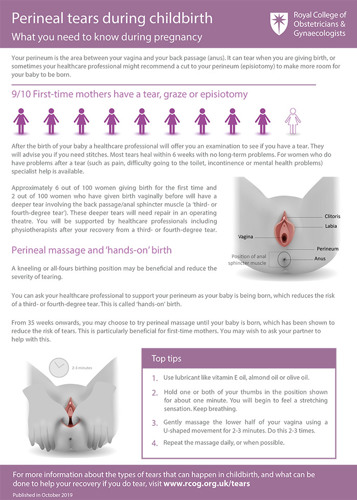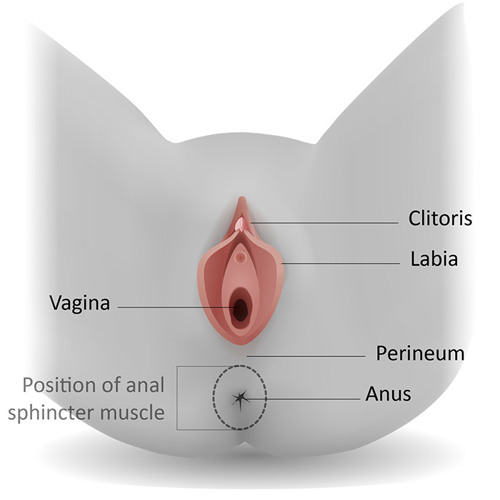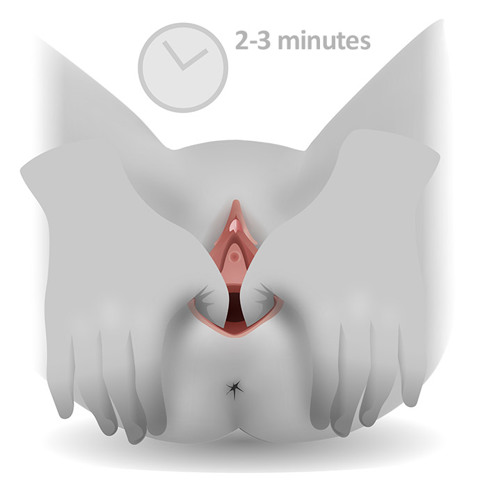Published: October 2019
Please note that this information will be reviewed every 3 years after publication.
This information is for you if you are pregnant and would like to know more about perineal tears during childbirth
It may also be helpful if you are a partner, friend or relative of someone who is in this situation.
Within this information, we may use the terms ‘woman’ and ‘women’. However, it is not only people who identify as women who may want to access this information. Your care should be personalised, inclusive and sensitive to your needs, whatever your gender identity.
A glossary of medical terms is available at A-Z of medical terms.
Read, listen, or download versions of the poster.
Black and white printable version
You can find further information on the RCOG perineal tears hub.

Text version: Perineal tears during childbirth
What you need to know during pregnancy
After the birth of your baby a healthcare professional will offer you an examination to see if you have a tear. They will advise you if you need stitches. Most tears heal within 6 weeks with no long-term problems. For women who do have problems after a tear (such as pain, difficulty going to the toilet, incontinence or mental health problems) specialist help is available.
Approximately 6 out of 100 women giving birth for the first time and 2 out of 100 women who have given birth vaginally before will have a deeper tear involving the back passage/anal sphincter muscle (a ‘third- or fourth-degree tear’). These deeper tears will need repair in an operating theatre. You will be supported by healthcare professionals including physiotherapists after your recovery from a third- or fourth-degree tear.

Image 1: Anatomy of the perineum without tears
Perineal massage and ‘hands-on’ birth
A kneeling or all-fours birthing position may be beneficial and reduce the severity of tearing.
You can ask your healthcare professional to support your perineum as your baby is being born, which reduces the risk of a third- or fourth-degree tear. This is called ‘hands-on’ birth.
From 35 weeks onwards, you may choose to try perineal massage until your baby is born, which has been shown to reduce the risk of tears. This is particularly beneficial for first-time mothers. You may wish to ask your partner to help with this.

Image 2: Example of perineal massage
Top tips
- Use lubricant like vitamin E oil, almond oil or olive oil.
- Hold one or both of your thumbs in the position shown for about one minute. You will begin to feel a stretching sensation. Keep breathing.
- Gently massage the lower half of your vagina using a U-shaped movement for 2-3 minutes. Do this 2-3 times.
- Repeat the massage daily, or when possible.
For more information about the types of tears that can happen in childbirth, and what can be done to help your recovery if you do tear, visit the RCOG perineal tears hub.
Sources and acknowledgements
This information has been developed by the OASI Care Bundle Project Team, OASI Care Bundle Clinical Champions and the RCOG Patient Information Committee.
It is based on the RCOG Green-top Guideline No. 29 The Management of Third- and Fourth-degree Perineal Tears, published in June 2015, and on expert opinion of the OASI Care Bundle Project Team, Clinical Champions, key stakeholders and the RCOG patient Information Committee, in line with RCOG due process. The guideline contains a full list of the sources of evidence we have used.
Before publication this information was reviewed by the public, by the RCOG Women’s Network and by the RCOG Women’s Voices Involvement Panel.
